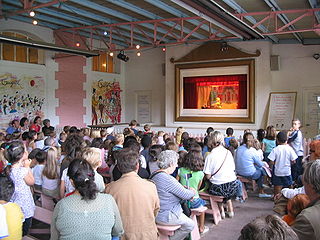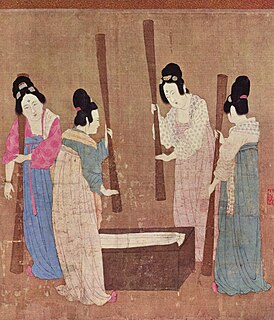Related Research Articles

The Jacquard machine is a device fitted to a loom that simplifies the process of manufacturing textiles with such complex patterns as brocade, damask and matelassé. The resulting ensemble of the loom and Jacquard machine is then called a Jacquard loom. The machine was invented by Joseph Marie Jacquard in 1804, based on earlier inventions by the Frenchmen Basile Bouchon (1725), Jean Baptiste Falcon (1728), and Jacques Vaucanson (1740). The machine was controlled by a "chain of cards"; a number of punched cards laced together into a continuous sequence. Multiple rows of holes were punched on each card, with one complete card corresponding to one row of the design.

Pope Clement V, born Raymond Bertrand de Got, was head of the Catholic Church and ruler of the Papal States from 5 June 1305 to his death in April 1314. He is remembered for suppressing the order of the Knights Templar and allowing the execution of many of its members. Pope Clement V was the pope who moved the Papacy from Rome to Avignon, ushering in the period known as the Avignon Papacy.

Guignol is the main character in a French puppet show which has come to bear his name. It represents the workers in the silk industry of France. Although often thought of as children's entertainment, Guignol's sharp wit and linguistic verve have always been appreciated by adults as well, as shown by the motto of a prominent Lyon troupe: "Guignol amuses children… and witty adults".

Villeurbanne is a commune in the Metropolis of Lyon in Auvergne-Rhône-Alpes region in eastern France.

Bertrand du Guesclin, nicknamed "The Eagle of Brittany" or "The Black Dog of Brocéliande", was a Breton knight and an important military commander on the French side during the Hundred Years' War. From 1370 to his death, he was Constable of France for King Charles V. Well known for his Fabian strategy, he took part in six pitched battles and won the four in which he held command.

Bertrand Tavernier was a French director, screenwriter, actor and producer.

Lyon or Lyons is the third-largest city and second-largest urban area of France. It is located at the confluence of the rivers Rhône and Saône, about 470 km (292 mi) southeast of Paris, 320 km (199 mi) north of Marseille and 56 km (35 mi) northeast of Saint-Étienne.

The production of silk originated in Neolithic period China within the Yangshao culture. Though it would later reach other places in the world, the art of silk production remained confined to China until the Silk Road opened at 114 BC, though China maintained its virtual monopoly over silk production for another thousand years. The use of silk within China was not confined to clothing alone, and silk was used for a number of applications, such as writing. Within clothing, the color of silk worn also held social importance, and formed an important guide of social class during the Tang dynasty.

Cervelle de canut is a cheese spread/dip, and a specialty of Lyon, France.

The Valois Tapestries are a series of eight large tapestries depicting festivities or "magnificences" held by Catherine de' Medici's Royal Courts in the second half of the 16th century. The tapestries were primarily modeled on drawings by Antoine Caron, but to Caron's distant views of large panoramas crowded with figures much larger portraits of leading persons at the French court have been added in the foreground, usually to the side, as well as elaborate borders.

Bertrand du Pouget was a French papal diplomat and Cardinal.

Lampas is a type of luxury fabric with a background weft typically in taffeta with supplementary wefts laid on top and forming a design, sometimes also with a "brocading weft". Lampas is typically woven in silk, and often has gold and silver thread enrichment.

The Palais de la Bourse or Palais du Commerce is a building located in the quarter Les Cordeliers, in 2nd arrondissement of Lyon. It currently houses the headquarters of the Chamber of Commerce and Industry of Lyon. It is served by the metro station Cordeliers, and by bus lines C3,13, 18, 23, 25, 28, 58, 71, 91 and 99.

The coussin de Lyon is a sweet specialty of Lyon, France, composed of chocolate and marzipan and created by Voisin, a French chocolatier. This tidbit is a piece of pale green marzipan, with dark green stripe, filled with a chocolate ganache flavored with curaçao liqueur.
The revolt of Lyon against the National Convention was a counter-revolutionary movement in the city of Lyon during the time of the French Revolution. It was a revolt of moderates against the more radical National Convention, the third government during the French Revolution. It broke out in June 1793 and was put down in October of the same year, after government forces had besieged the city.

The Cloth of St Gereon is a mural tapestry of a repeat pattern with a decorative motif of a bull being attacked by a griffin, a fantastic creature with the body of a lion and the head and wings of an eagle. The Cloth of St Gereon is regarded as the oldest or second oldest known European tapestry still existing, dating to the early 11th century, compared to the Överhogdal tapestries, which in 2005 were redated to the same period, or a little later. A number of European museums hold sections of the original cloth, which was cut into fragments in the 19th century.

Bertrand Isidore Traoré is a Burkinabé professional footballer who plays as a forward for Premier League club Aston Villa and the Burkina Faso national team.

The Textile Arts Museum is a museum in the city of Lyon, France. Located in two 18th century hôtels particuliers of Lyon's 2nd arrondissement, the institution consists in two distinct collections : the textiles collection and the decorative arts collection.

Jean-François Bony was a French painter, draftsman, embroiderer, silk manufacturer, and flower painter. A talented artist, his designs include studies of a dress and mantle proposed for the wearing of Josephine de Beauharnais at the coronation of Napoleon. Bony was active before, during and after the French Revolution, also designing fabrics for Marie Antoinette, Empress Marie Louise and Napoleon himself.

The Death of Polydorus is one of a set of seven tapestries showing a scene from the Iliad by Homer, here the death of Priam's son Polydorus in book VI, link 290 and book XXIV, line 49. It was produced between 1623 and 1626 and is now in the Museum of Fine Arts of Lyon, as is another piece from the set. They are technically embroidery rather than being in a tapestry weave, but the images of the faces and flesh parts of the figures are appliqué painted silk satin pieces, reflecting a Chinese technique often used for Buddhist banners. The painting may have been done by Western artists, possibly in Europe. It measures 3.7 by 4.9 metres.
References
- ↑ "The History of Henry Bertrand". HenryBertrand.co.uk. Retrieved 15 March 2013.